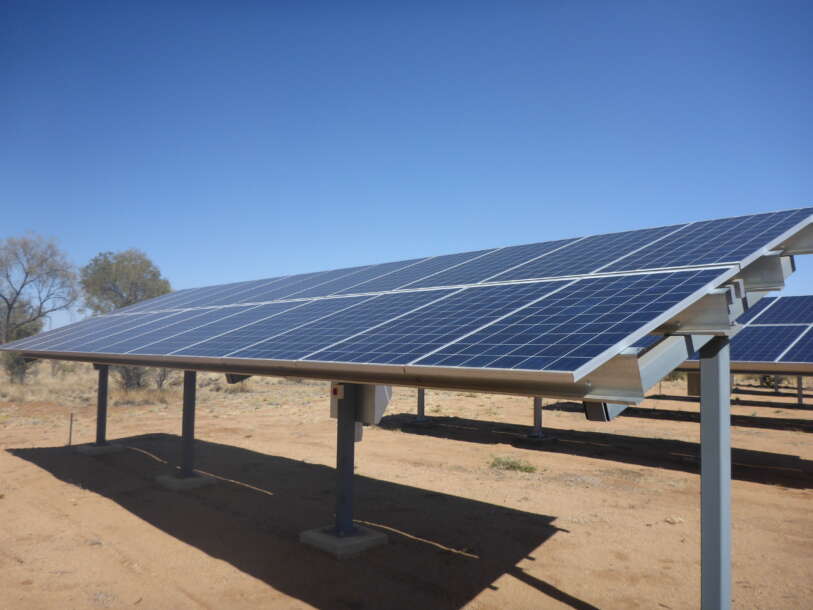| Manufacturer | REC |
|---|---|
| Array Rating | 5.5kW |
| PV Technology | poly-Si |
| Array Structure | Fixed: Ground Mount |
| Installed | 2012 |
View on Map Graphs Download Data
Current Output

| Array Rating | 5.5kW |
|---|---|
| Panel Rating | 250W |
| Number Of Panels | 22 |
| Array Area | 36.23 m² |
| Type Of Tracker | N/A |
| Inverter Size / Type | 6 kW Fronius Primo replaced 6 kW SMC 6000A on 29/4/22 |
| Installation Completed | Mon, 12 Nov 2012 |
| Array Tilt/Azimuth | Tilt = 20, Azi = 0 (Solar North) |

Notes on the Data
-
Inverters replaced
Failed inverters on sites 8,32,33 and 34 have been replaced with Fronius Primo 6kW inverters. These systems are now generating normally again.
-
Failed Inverters
In addition to the failed inverter on site 33, additional inverter issues have been identified at the following sites.
- Site 32, complete failure.
- Site 34, intermittent issue.
- Site 12, Intermittent issue, tends to be in the middle of the day.
Remediation work is underway for each array.
-
Some system issues.
The following sites have on going power issues due to a range of factors:
- Site 1A dysfunctional tracker
- Site 1B 2 x Failed PV inverters and dysfunctional trackers
- Site 2 2 x Failed PV inverters and dysfunctional tracker
- Site 5 AC cable fault
- Site 22 1 x failed tracker
- Site 33 1 x Failed PV inverter
Remediation work is underway and each array will be returned to full operation as soon as possible.
-
Metering failure
Circuit breaker supplying the metering equipment for sites 23-38 tripped off on Aug 19th and was discovered and turned back on on Aug 23rd. This resulted in a lack of generation data for these sites during this time but did not stop the sites from physically generating.
-
Site #33 REC Array Outage
Site #33 REC went offline ~ 24TH March 2021. Inverter is currently shutdown. The cause of the issue and solution TBD.
-
System Disconnection for Cabling Works
All arrays at the Solar Centre were disconnected from approximately 2.00pm to 3.00pm on Monday, 9 July 2018 in preparation for the cable between the main switchboard and distribution board being upgraded. Array sites #23-38 remained disconnected while the main feeder cable to these sites was replaced in subsequent days, but all systems were re-connected by early afternoon on Thursday, 12 July 2018.
-
System Outage at Australia Day Long Weekend
A breaker tripped at around 12.30pm on Friday, 26 January, likely due to high generation levels reached at this peak time on this high irradiance day. Connection was restored after the Australia Day long weekend at around 11.30am on Monday, 29 January but shortly tripped again.
UPDATE 26-02-2018. The cause of this reoccurring issue has been identified and will be rectified. The solution requires the upgrading of a key distribution cable. This should be completed in the coming months.
-
Connection Restored After Christmas/NY Period
Arrays have been re-connected following the outage that disconnected multiple sites from Christmas day 2017. The outage is believed to have been triggered by the tripping of two circuit breakers in separate distribution boards, making the diagnosis initially elusive. The ability of the common circuit shared by these arrays to keep abreast with increasingly high current demands as new arrays are installed and generation conditions are high is presently being addressed. For the same reason, intermittent outages persisted in the summer of early 2018.
-
System Outage at Christmas/NY Period
A system outage was caused by a circuit breaker trip at approximately 2pm on a high generation day shortly after installation of a new array at the DKA Solar Centre. The outage commenced on 25 December continuing into the new year and is being addressed.
-
System Outage for New Array Connection
Sites 23 through to 37 experienced an outage today from 11:10 to 11:50. The outage was due to the local distribution board being temporarily being taken offline to allow for the connection of a new PV system.
-
Monitoring Interruption for UPS Battery Replacement
The disconnection and re-connection of the solar arrays and weather station equipment while a new site connection was being established prompted the already flattening UPS batteries which power the site’s energy meters to fail and require immediate replacement. Data recording was affected from approximately 2.30pm ACST, Monday 10 July to 4.00pm, Wednesday 12 July.
Affects weather data for DKASC, Alice Springs
-
Partial System Outage
One of the major switchboards at the DKASC lost power yesterday 01/12/2016 at ~11:00 am. This isolated and shutdown array sites 23 through to 37 inclusive. The switchboard was re-energised at ~16:30 today (02/12/2016) and is again operating normally. Data for this period for these sites is lost.
> Answer to Spotlight Question
Onsite at the DKA Solar Centre in Alice Springs are a series of quiz-like Spotlight Questions at each array. Visit the centre and scan the QR code at each sign to test your knowledge – and check your answer here!
Q: Why is it desirable to design solar modules to respond differently to different colours of light?
A: Sunlight consists of all the colours of the rainbow; white light may look "colourless" but actually includes every shade from red to yellow, green to purple and all the steps in between. While many solar modules are designed to maximise overall sunlight exposure/absorption but not take advantage of individual colours, some technologists are finding ways to optimise sunlight absorption on a colour-by-colour basis, combining different technologies that are each specialised to absorb a different component of sunlight, so that the module overall extracts as much power as possible from all received sunlight. Optimising absorption across the spectrum is tantamount to optimising absorption throughout the day, as well as throughout different sky conditions (such as blue-skied or clouded), since the relative intensities of individual colours in the sunlight change with those conditions.

